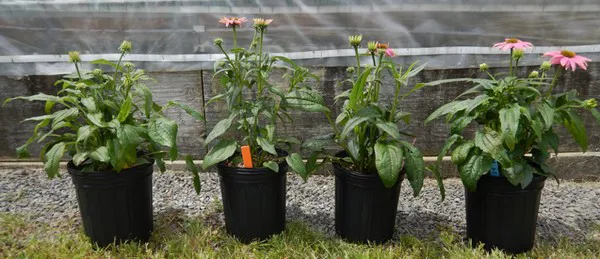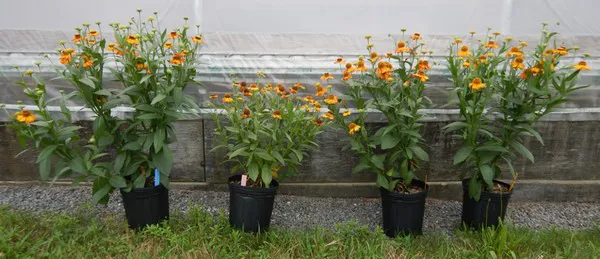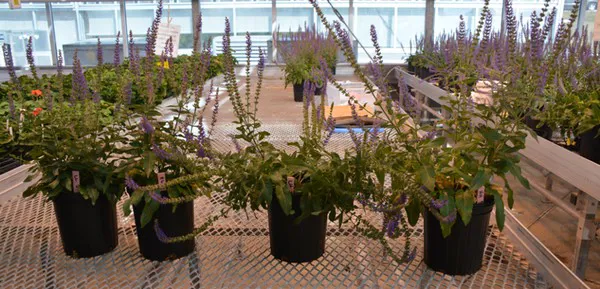The visual appearance of plant materials is an important purchasing factor for consumers. Uneven growth, poor branching, wilting, and nutrient deficiencies can reduce the salability of plants. Insufficient irrigation and fertilization can impact various aspects of growth including height, internode length, and leaf area. Over-irrigation and over-fertilization can also result in unfavorable growth responses. Excessive growth often results in leggy, floppy plants with uneven growth; these plants have a greater potential for damage during shipping or in the retail setting. Reduced irrigation and fertilizer inputs can lessen the environmental impact of production by reducing the nutrient-laden coming from the production area. Reduced irrigation also has the potential to be used as a method of plant growth control in place of plant growth regulators or hand pruning.
By Dr. Amanda Bayer, University of Massachusetts Amherst
Another important consideration is the impact of production practices on flowering. Many plants, including herbaceous perennials, sell best when in bloom. Both irrigation and fertilization practices have the potential to alter flowering, including the number of flowers and timing of bloom. Research has shown there is a species-specific response of reduced irrigation on flowering with increased blooming in some species and reduced flowering in others. Research at the University of Massachusetts Amherst is looking at the impact of reduced irrigation and fertilization on growth and flowering of herbaceous perennial species. The goal of the research is to gain a better understanding of herbaceous perennial water and nutrient requirements while also understanding how irrigation can be used to control plant growth. The research will also provide information on the potential for reducing the inputs needed for herbaceous perennial production.

Growth of Echinacea purpurea ‘PAS702917’ (pow wow wild berry)plants maintained at 38% (WW) or 25% (RI) substrate water content or receiving an alternating treatment that supplied reduced irrigation (25%) for either the first two weeks (RIWW) or final 4 weeks of production (WWRI).
We first looked at the effect of reduced irrigation on plant growth and the potential for alternating substrate volumetric water during production as a means of growth control. Irrigation was applied via a soil moisture sensor automated irrigation system to maintain either 20% (reduced irrigation) or 38% (well-watered) substrate water content. For the alternating treatments, substrate water content was either maintained at 20% for either the first two weeks (20% followed by 38%) or the final four weeks of production (38% followed by 20%). For echinacea, the reduced irrigation was 25% substrate water content.
Plant response to treatment was species-specific but there were some commonalities. The flower number was not different between treatments for Salvia nemorosa ‘Ostfrieland’ or Echinacea purpurea ‘PAS702917’ (pow wow wildberry). The 40% treatment had the greatest number of flowers for Heleinium hybrida ‘Helbro’. Plant height was not affected by treatment for Salvia and was greatest for plants receiving the well-watered treatment for helenium and the well-watered and alternating treatment ending with well-watered conditions for echinacea. Echinacea shoot dry weight was unaffected by treatments, whereas well-watered treatments resulted in the greatest shoot dry weight for Helenium and the well-watered and alternating treatment ending with well-watered conditions the greatest shoot dry weight for Salvia. Overall, plants receiving the reduced irrigation treatments were smaller but the most visually appealing. Salvia plants that received the alternating irrigation that maintained 20% followed by 38% volumetric water content had an open, floppy habit that would impact the salability of the plants. This suggests that alternating irrigation during the production of Salvia nemorosa ‘Ostfrieland’ from a lower volume to a higher volume can result in unfavorable, excessive plant growth; however, reduced irrigation would be recommended. The well-watered Heleinum were very large and less visually appealing, although not as floppy as the Salvia receiving the reduced irrigation, well-watered alternating treatment. These experiments demonstrate a species-specific response to reduced irrigation treatments with the more drought-tolerant Echinacea, less impacted than the Helenium and Salvia.

Growth of Helenium hybrida ‘Helbro’ plants maintained at 38% (WW) or 20% (RI) substrate water content or receiving an alternating treatment that supplied reduced irrigation (20%) for either the first two weeks (RIWW) or final 4 weeks of production (WWRI).
We then looked at the impact of reduced irrigation and fertilizer rate on the growth and flowering of Penstemon x ‘Ruby Candle’. As soil moisture sensor automated irrigation systems were used to maintain substrate volumetric content at either 40% (well-watered) or 18% (reduced irrigation). A controlled-release fertilizer was applied at 100%, 50%, or 25% of the medium recommended bag rate (12 g/plant). Flowering was not impacted by treatments. Average plant height was greatest for the 50% fertilizer rate but was not affected by irrigation treatment. Conversely, internode length was greater for the well-watered treatments but was unaffected by fertilizer rate. Plant fresh weight was greater for WW than RI plants and the 100% fertilizer rate than the 25% fertilizer rate. The results of this experiment show the potential for reducing fertilizer applications up to 50% while not having a significant impact on plant growth.

Growth of Salvia nemorosa ‘Ostfrieland’ plants maintained at 38% (WW) or 20% (RI) substrate water content or receiving an alternating treatment that supplied reduced irrigation (20%) for either the first two weeks (RIWW) or final 4 weeks of production (WWRI).
What does this mean to the floriculture industry?
There was a species-specific response to reduced irrigation treatments and alternating irrigation treatments; however, reduced irrigation generally produced more compact, more visually appealing plants. The exuberant growth seen by the Helenium, Salvia, and Penstemon receiving the well-watered treatments demonstrates the irregular growth that can be seen with excessive irrigation. Plant growth response to reduced fertilizer rates shows the potential for reductions in fertilizer applications up to 50% without negatively impacting growth.
These results indicate the potential for reduced fertilizer and irrigation applications in perennial production. Reduced inputs also have the potential to reduce fertilizer leaching and runoff. More compact plant growth will also be favorable for shipping, increasing the number of plants that can fit on a truck and decreasing the potential for plant damage due to branch breakage.
Click here for additional information.
